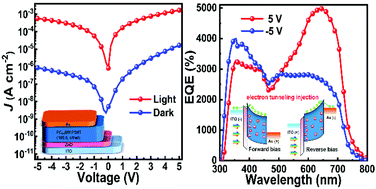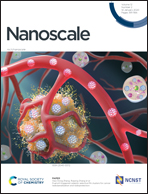Photomultiplication type organic photodetectors based on electron tunneling injection†
Abstract
Photomultiplication (PM) type organic photodetectors (OPDs) based on electron tunneling injection are achieved with a specific structure of ITO/ZnO/PC71BM:P3HT (100 : 5, wt/wt)/Au and can work well under forward and reverse bias. A rather low dark current density of the PM type OPDs is obtained due to the large electron injection barrier of 0.7 eV from the ITO electrode or 1.1 eV from the Au electrode, as well as the absence of continuous hole transport channels in the active layers. The external quantum efficiency (EQE) spectral shape of PM type OPDs can be easily adjusted by altering the bias polarity and active layer thickness, which can be well explained by the trapped hole distribution near the ITO and Au electrodes, respectively. The PM type OPDs with 400 nm active layers exhibit the maximum EQE of 3900% and 4900% under 5 V and −5 V bias, respectively. This work firstly achieves PM type OPDs with electron-only transport properties, which has great potential to well match with other organic electronic devices.

- This article is part of the themed collections: Nanoscale 2021 Lunar New Year Collection and Nanoscale Most Popular 2020 Articles


 Please wait while we load your content...
Please wait while we load your content...